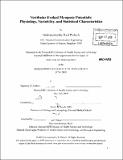| dc.contributor.advisor | Steven D. Rauch. | en_US |
| dc.contributor.author | Prakash, Srinivasamurthy Ravi | en_US |
| dc.contributor.other | Harvard University--MIT Division of Health Sciences and Technology. | en_US |
| dc.date.accessioned | 2010-04-28T17:05:36Z | |
| dc.date.available | 2010-04-28T17:05:36Z | |
| dc.date.copyright | 2009 | en_US |
| dc.date.issued | 2009 | en_US |
| dc.identifier.uri | http://hdl.handle.net/1721.1/54587 | |
| dc.description | Thesis (Ph. D.)--Harvard-MIT Division of Health Sciences and Technology, 2009. | en_US |
| dc.description | Cataloged from PDF version of thesis. | en_US |
| dc.description | Includes bibliographical references. | en_US |
| dc.description.abstract | Vestibular Evoked Myogenic Potentials (VEMPs) are electrical signals recorded from the skin overlying skeletal muscles of the head and neck in response to high-intensity acoustic stimuli. VEMPs have been observed in stimulus locked averages of the electromyogram in a majority of human subjects, and are thought to originate in the otolith organs of the inner ear, which are balance organs responsible for sensing acceleration and orientation with respect to gravity. Otolith reflexes interact with the motor drive to a contracted muscle to give rise to the VEMP signal. In the last few years these signals have been used in the clinic as an indicator of peripheral vestibular function and a test based on VEMP from neck muscles (cervical, or cVEMP) is currently the only clinically feasible means of assessing the functioning of the saccule and its innervation. However, the usefulness of the test is limited by the inter-subject and test-retest variability of the response, and the unclear relationship between specific response features and vestibular pathophysiology. In this thesis, our goal is to measure VEMP variability, assess the influence of non-vestibular factors on the VEMP, and to develop a signal processing strategy to estimate response parameters that are both statistically stable, and physiologically meaningful. In the first part of the thesis, we systematically measure VEMPs from a small clinically normal population, and quantify the variability of the response, particularly the dependence on contraction effort. We also assess approaches to normalizing the response by estimates of the effort. | en_US |
| dc.description.abstract | (cont.) In the second part of the thesis, we develop a computational model of VEMP physiology, and use the model to separate external sources of variability from internal noise. The model outputs are also used to define a statistical measure, the inverse coefficient of variation (iCOV), which correlates with altered vestibular sensitivity, but is relatively robust to other changes. When applied to the experimental data, the iCOV is found to yield estimates of vestibular sensitivity that are more stable than the conventional VEMP amplitude. This measure also reveals a diversity of response threshold and growth characteristics within the clinically normal population. These findings suggest that the proposed approach could lead to the development of an improved clinical tool, but could also yield new insights into the physiological mechanisms of vestibular pathology. | en_US |
| dc.description.statementofresponsibility | by Srinivasamurthy Ravi Prakash. | en_US |
| dc.format.extent | 144 p. | en_US |
| dc.language.iso | eng | en_US |
| dc.publisher | Massachusetts Institute of Technology | en_US |
| dc.rights | M.I.T. theses are protected by
copyright. They may be viewed from this source for any purpose, but
reproduction or distribution in any format is prohibited without written
permission. See provided URL for inquiries about permission. | en_US |
| dc.rights.uri | http://dspace.mit.edu/handle/1721.1/7582 | en_US |
| dc.subject | Harvard University--MIT Division of Health Sciences and Technology. | en_US |
| dc.title | Vestibular Evoked Myogenic Potentials : physiology, variability, and statistical characteristics | en_US |
| dc.title.alternative | VEMPs : physiology, variability, and statistical characteristics | en_US |
| dc.type | Thesis | en_US |
| dc.description.degree | Ph.D. | en_US |
| dc.contributor.department | Harvard University--MIT Division of Health Sciences and Technology | |
| dc.identifier.oclc | 569384411 | en_US |

